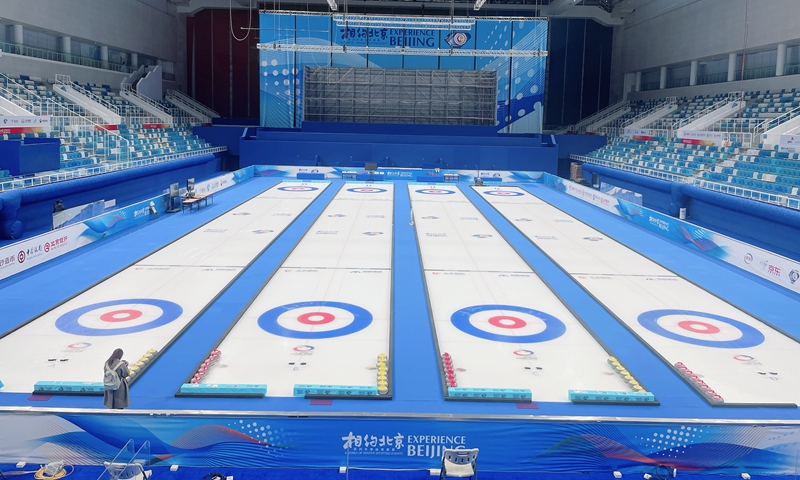
The Beijing Winter Olympics main curling venue, dubbed the "Ice Cube," is reconstructed from a swimming pool. Photo: Cui Fandi/GT
The "Ice Cube," the reconstructed venue formerly known as the "Water Cube," which has been dedicated to the Beijing Olympic Winter Games, is expected to hold about one-fifth of the full audience capacity during the Games due to epidemic concerns, and will become a model for Olympic venues to be able to change between water and ice sports facilities after the Games, the general manager of the facility told the Global Times on Thursday.
"For the Winter Olympic curling events in the main competition area in the Ice Cube, attendance is expected to be no more than 1,000 people," said Yang Qiyong, general manager of the venue, citing COVID-19 control mechanisms.
Public information shows that the main competition area has a total of 4,600 spectator seats. The actual spectator attendance at the Winter Olympics will be less than 1,000.
The Ice Cube has held several rounds of test matches without any audience members, during which the arena operating team rehearsed COVID-19 prevention and control methods, Yang told the Global Times.
"In every test round we previously played in the Ice Cube, all in-venue personnel entered the closed-loop management 30 days ahead of the game," said Yang, who is also deputy head of the venue's logistics department. "The same mode will be adopted for the Winter Olympics."
"All positions will be prepared with back-up personnel to ensure that there is always a back-up to take over if any one has an epidemic-related problem."
All personnel have received two shots of COVID-19 vaccines as of June, and they have now all been given a booster shot, Yang said.
The Ice Cube was reconstructed from the renowned Water Cube, formally known as the National Aquatics Center. The Cube was originally built for the Beijing 2008 Summer Olympics and reconstructed in 2019 for the 2022 Winter Olympics, demonstrating Beijing's idea of a sustainable Olympics.
Instead of completely reconstructing the arena, Beijing chose to do it with "traditional Chinese wisdom" to retain the Summer Olympic memories, Sun Weihua, head of the curling renovation project of the National Aquatics Center, said on Thursday.
"The International Olympic Committee (IOC) initially suggested that we fill in the main pool and turn it into an ice rink," Sun said. "But given that the pool has captured the memories of many athletes and spectators over the years, we wanted to keep it."
In the end, the Ice Cube became the first arena in the world that can switch "between water and ice." Its pool and ice rink can be switched with each other in a short 19 days.
After the Winter Olympics, the facility will keep switching between the swimming season and ice season and will serve the public. In the spring, summer and fall, it will be used for water sports, while in the winter it will be used for ice sports, becoming a model of sustainable use of Olympic venues.
The Beijing Winter Olympics will be held from February 4 to 20, 2022 in Beijing, its Yanqing district, and neighboring Zhangjiakou, North China's Hebei Province.




